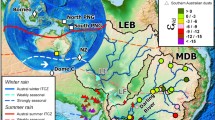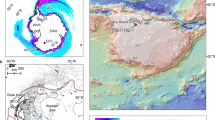Abstract
The discussion on climatic instability observed in Greenland ice cores during the Eemian period (substage 5e) resulted in discovery of a pronounced mid-Eemian cooling event. We report that the mid-Eemian cooling is found for the first time in the biogenic silica climatic record and microfossil abundance record of Lake Baikal. Timing of this event in Lake Baikal correlates well with timing of the European pollen records and marine sedimentary records. The presence of the mid-Eemian cooling signal in the Lake Baikal record suggests a much closer link between Asian climate influenced by strong pressure fields over the vast land masses and the climate-controlling processes in the North Atlantic during interglacial periods, than what was generally believed. Furthermore, the Lake Baikal record suggests that after the mid-Eemian cooling, the climatic conditions returned close to the warmth of the 5e optimum and thus argues that the warm conditions of the last interglacial persisted in Siberia throughout 5e, and did not end with the mid-Eemian cooling as suggested by several published marine records.
Similar content being viewed by others
References
Adkins, J. F., E. A. Boyle, L. Keigwin & E. Cortijo, 1997. Variability of the North Atlantic thermohaline circulation during the last interglacial period. Nature 390: 154–156.
Alley, R. B., A. J. Gow, S. J. Johnsen, J. Kipfstuhl, D. A. Meese & T. Thorsteinsson, 1995. Comparison of deep ice cores. Nature 373: 393–394.
BDP-Members, 1997a. Preliminary results of the first drilling on Lake Baikal, Buguldeika site, southeastern Siberia. Quat. Int. 37: 3–17.
BDP-Members, 1997b. Continuous paleoclimate record of last 5 MA from Lake Baikal, Siberia. EOS Am. Geophys. Union Trans. 78: 597–604.
Bezrukova, E. V., Y. A. Bogdanov, D. F. Williams, L. Z. Granina, M. A. Grachev, N. V. Ignatova, E. B. Karabanov, V. M. Kuptzov, A. B. Kurylev, P. P. Letunova, E. V. Likhoshway, G. P. Chernyaeva, M. K. Shimaraeva & A. O. Yakushin, 1991. Deep changes of North Baikal ecosystem in Holocene. Doklady AN SSSR 321: 1032–1037 (in Russian).
Bradbury, J. P., E. V. Bezrukova, G. Chernyaeva, S. M. Colman, G. Khursevich, J. King & Y. Likhoshway, 1994. A synthesis of post-glacial diatom records from Lake Baikal. J. Paleolim. 10: 231–251.
Colman, S. M., J. A. Peck, G. A. Jones, E. B. Karabanov, S. J. Carter, J. P. Bradbury, J. W. King & D. F. Williams, 1995. Continental climate response to orbital forcing from biogenic silica records in Lake Baikal. Nature 378: 769–771.
Cortijo, E., J. C. Duplessy, L. Labeyrie, H. Leclaire, J. Duprat & T. C. E. van Weering, 1994. Eemian cooling in the Norwegian Sea and North Atlantic ocean preceding continental ice-sheet growth. Nature 372: 446–449.
Dansgaard, W., S. J. Johnsen, H. B. Clausen, D. Dahl-Jensen, N. S. Gundestrup, C. U. Hammer, C. S. Hvidberg, J. P. Steffensen, A. E. Sveinbjornsdottir, J. Jouzel & G. Bond, 1993. Evidence for general instability of past climate from a 250-kyr ice-core record. Nature 364: 218–220.
Flower, R. J., A. W. Mackay, N. Rose, J. L. Boyle, P. G. Dearing, A. E. Appleby, A. E. Kuzmina & L. Z. Granina, 1995. Sedimentary records of recent environmental change in Lake Baikal, Siberia. The Holocene 5: 323–327.
GRIP-Members, 1993. Climate instability during the last interglacial period recorded in the GRIP ice core. Nature 364: 203–207.
Grootes, P. M., M. Stuiver, J. W. C. White, S. Johnsen & J. Jouzel, 1993. Comparison of oxygen isotope records from the GISP2 and GRIP Greenland ice cores. Nature 366: 552–554.
Johnsen, S. J., H. B. Clausen, W. Dansgaard, N. S. Gunderstrup, C. U. Hammer & H. Tauber, 1995. The Eem stable isotope record along the GRIP ice core and its interpretation. Quat. Res. 43: 117–124.
Karabanov, E. B., A. A. Prokopenko, D. F. Williams & S. M. Colman, 1998. Evidence from Lake Baikal for Siberian Glaciation during Oxygen-Isotope Substage 5d. Quat. Res. 50: 46–55.
Keigwin, L. D., W. B. Curry, S. J. Lehman & S. Johnsen, 1994. The role of the deep ocean in North Atlantic climate change between 70 and 130 kyr ago. Nature 371: 323–326.
Khursevich, G. K., 1989. Atlas of species Stephanodiscus and Cyclostephanos (Bacillariophyta) from the Upper Cenozoic deposits of USSR. Nauka i Tekhnika, Minsk, 167 pp (in Russian).
Lambeck, K. & M. Nakada, 1992. Constraints on the age and duration of the last interglacial period and on sea-level variations. Nature 357: 125–128.
Larsen, E., H. P. Sejrup, S. J. Johnsen & K. L. Knudsen, 1995. Do Greenland ice cores reflect NW European interglacial climate variations? Quat. Res. 43: 125–132.
Mangerud, J., E. Sonstegaard & H.-P. Sejrup, 1979. Correlation of the Eemian (interglacial) Stage and the deep-sea oxygen-isotope stratigraphy. Nature 277: 189–192.
Martinson, D. G., N. G. Pisias, J. D. Hayes, J. Imbrie, T. Moore & N. J. Shackleton, 1987. Age dating the orbital theory of the ice ages. Development of a high-resolution 0 to 300,000-year chronostratigraphy. Quat. Res. 27: 1–29.
Maslin, M. & C. Tzedakis, 1996. Sultry last interglacial gets sudden chill. EOS, Trans. Am. Geophys. Union 77: 353–354.
McManus, J. F., G. C. Bond, W. S. Broecker, S. Johnsen, L. Laberie & S. Higgins, 1994. High-resolution climate records from the North Atlantic during the last interglacial. Nature 371: 326–329.
Mortlock, R. A. & P. N. Froelich, 1989. A simple method for the rapid determination of biogenic opal in pelagic marine sediments. Deep-Sea Res. 36: 1415–1426.
Scholle, P. A., 1979. A color illustrated guide to constituents, textures, cements and porosities of sandstones and associated rocks. AAPG Memoir 28.
Stirling, C. H., T. M. Esat, M. T. McCulloch & K. Lambeck, 1995. High-precision U-series dating of corals from Western Australia and implications for the timing and duration of the last interglacial. Earth Planet. Sci. Lett. 135: 115–130.
Taylor, K. C., C. U. Hammer, R. B. Alley, H. B. Clausen, D. Dahl-Jensen, A. J. Gow, N. S. Gundestrup, J. Kipfsthul, J. C. Moore & E. D. Waddington, 1993. Electrical conductivity measurements from the GISP2 and GRIP Greenland ice cores. Nature 366: 549–552.
Terry, R. D. & G. V. Chilingar, 1955. Summary of ‘Concerning some additional aids in studying sedimentary formations’ by M. S. Shvetsov. J. Sed. Petrol. 25: 229–234.
Touveny, N., J.-L. Beaulleu, E. Bonifay, K. M. Creer, J. Guiot, M. Icole, S. Johnsen, J. Jouzel, M. Reille, T. Williams & D. Williamson, 1994. Climate variations in Europe over the past 140 kyr deduced from frock magnetism. Nature 371: 503–506.
Tzedakis, P. C., K. D. Bennett & D. Magri, 1994. Climate and the pollen record. Nature 370: 513.
Velichko, A. A., 1984. Late Pleistocene spatial paleoclimatic reconstructions. In: A. A. Velichko (ed.), Late Quaternary Environments of Soviet Union: 261–285. University of Minnessota Press, Minneapolis.
Williams, D. F., J. Peck, E. B. Karabanov, A. A. Prokopenko, V. Kravchinsky, J. King & M. I. Kuzmin, 1997. Lake Baikal record of continental climate response to orbital insolation during the past 5 million years. Science 278: 1114–1117.
Woillard, G. M., 1978. Grande Pile peat bog: A continuous pollen record for the last 140,000 years. Quat. Res. 9: 1–21.
Author information
Authors and Affiliations
Rights and permissions
About this article
Cite this article
Karabanov, E.B., Propenko, A.A., Williams, D.F. et al. Evidence for mid-Eemian cooling in continental climatic record from Lake Baikal. Journal of Paleolimnology 23, 365–371 (2000). https://doi.org/10.1023/A:1008188100542
Issue Date:
DOI: https://doi.org/10.1023/A:1008188100542




